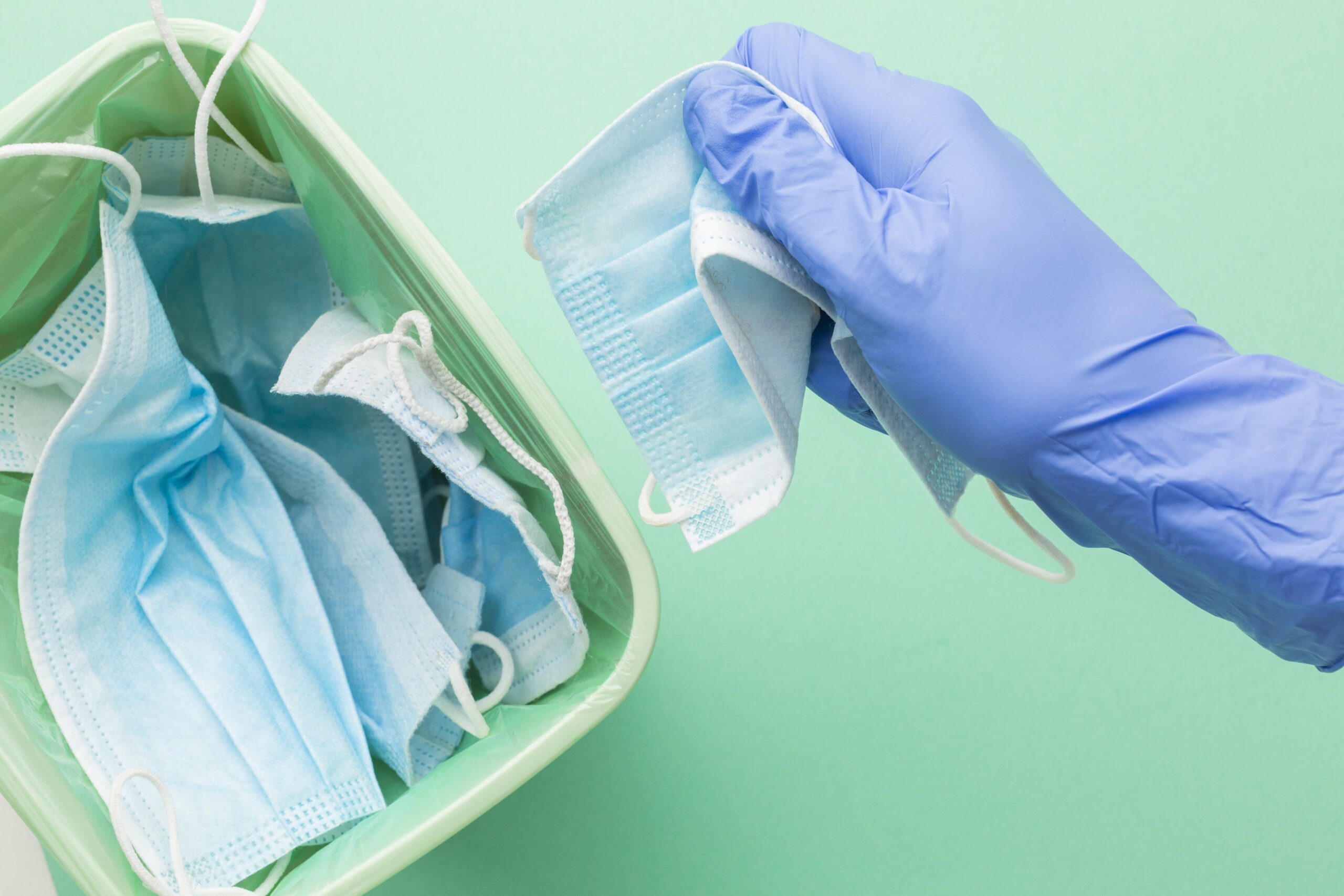Health care waste may be defined as any undesirable or superfluous by-product, emission, residue or remainder generated by in the course of health care by healthcare professionals, healthcare facilities and other non-healthcare professionals, which is discarded, accumulated and stored with the purpose of eventually discarding it, or is stored with the purpose of recycling, re-using or extracting a usable product from such matter. Health care waste may, if handled improperly, have the potential to harm people, property or the environment. In this regard, all human anatomical waste, blood and body fluids are considered to be potentially hazardous. The unsafe disposal of such waste could have detrimental effects for people who might come into contact with health care waste.
For the purpose of these guidelines, the following would be considered to be hazardous health care waste:
- Infectious waste
- Pathological waste, including body fluids, secretions and surgical specimens
- Sharps, especially contaminated sharps
- Pharmaceutical waste
- Chemical waste
- Heavy metals
- Radioactive waste
- Genotoxic waste
- Cytotoxic agents
- Pressurised containers
Health care waste is a significant danger to society because:
- Unsafe management of hazardous health care waste, particularly in its disposal, may increase the risk of needle stick injuries, transmission of infectious agents and expose unsuspecting parties to unnecessary and entirely preventable risks. The severity of the risk associated with such exposures may be difficult to quantify, and such exposures should be prevented.
- Health care waste entering the normal domestic waste stream will end up being disposed of in municipal landfill sites. When health care waste is placed in landfills or buried, contamination of groundwater may occur and may result in the spread of E-Coli and unacceptably high COD readings. (Expressed as parts per million, the higher the Chemical Oxygen Demand of the sample, the higher the level of pollution.)
- Many smaller landfill sites are not fenced off and have poor security. This results in unwanted tip-face picking and scavenging. If health care waste is disposed on such a site, there is a risk of exposure to people scavenging on the sites.
- The irresponsible and illegal dumping of hazardous health care waste in South Africa, as intermittently reported in the media, is a matter or serious concern. It also places an unacceptably high financial and human resources burden on health authorities to manage the problem.
- The burning of health care waste as opposed to incineration is not recommended as it pollutes the environment, especially through the formation of dioxins. Incineration should only be used where it meets specifications that avoid secondary pollutant emissions.
All medical sharps should be considered hazardous healthcare waste whether or not contaminated with infectious agents. The proper use and disposal of suitable sharps containers contributes to the minimization of injuries and transmission of potentially harmful agents. It is important that the health care practitioner make use of sharp containers that are suited for the purposes of disposing of sharps. Such containers should not puncture easily, should be stable and durable enough to withstand a fall onto a hard surface.
When using sharps containers for discarded needles and other sharp health care waste, health care practitioners should ensure that the containers are not filled beyond their fill capacity, and are maintained upright throughout their use during handling, storage and transport. Do not reuse sharps containers designed, manufactured and intended for single-use purposes.
Health care practitioners have an obligation to report evidence of unsafe disposal or management of health care waste by other persons, including any health care practitioners, to the Department of Health, should such unsafe practice come to their attention.
Because the medical waste of funeral homes does not fit neatly into the medical waste disposal categories that have been established, the National Funeral Directors’ Association of the USA has prepared a Funeral Home Medical Waste Protocol to assist funeral directors with the proper characterization, handling and disposal of medical waste. This protocol recognizes that funeral directors discharge embalming wastewater to publicly owned treatment works and to septic systems and that if embalming products are properly handled, funeral homes generally do not generate hazardous wastes.
Accepted Medical Waste
The following medical wastes are considered acceptable for disposal:
• Sharps (any object that may be contaminated with an infectious substance, and able to cut or penetrate the skin or packaging material. This includes needles, syringes, scalpels, broken glass, culture slides, culture dishes, broken capillary tubes, broken rigid plastic, and exposed ends of dental wires. For funeral homes, sharps needles, suture needles, syringes, scalpel blades; autopsy needles, dental wires, and similar objects, which are not cleaned and disinfected for re-use, are to be placed in the designated sharps container for periodic disposal.)
• Materials that accompany the deceased to the funeral home (plastic and cloth sheeting; gauze; leftover IV tubing; is posable gloves, gowns, booties, and masks; hospital wrappings such as catheters and casts; and other disposable equipment, instruments or materials that have come in contact with bodily fluids, blood, or any infectious agents categorized by the World Health Organization as Risk Groups 2 or 3, such as CJD, anthrax, hantavirus, Hepatitis B, HIV, or influenza. Ordinarily the applicable Risk Group should be determined by the treating physician or other health professional prior to the deceased arriving at the funeral home. Risk Group 4 materials may not be discarded as regulated medical waste.
• Materials that are used in the preparation room (tubes; disposable gloves, gowns, and other garments, gauze and cloths used in embalming and other disposable equipment, instruments or materials that have come in contact with bodily fluids, blood, or infectious agents categorized by the World Health Organization as Risk Groups 2 or 3, such as CJD, anthrax, hantavirus, Hepatitis B, HIV, or influenza, and materials having trace amounts of embalming fluids containing formaldehyde and phenol.)
Accepted medical waste to be labeled and segregated for incineration
Pathological and trace chemotherapy wastes ordinarily should be incinerated and labeled for incineration. Funeral homes typically do not produce chemotherapy or pathological wastes and any autopsy-related or other viscera, organs or tissues that accompany the deceased to the funeral home will be included with the remains for burial or cremation.
Funeral homes take steps to ensure that medical waste is not transported to the funeral home with the deceased. In the event that medical waste accompanies the deceased to the funeral home and the funeral home cannot determine the exact nature of the medical waste, the funeral director agrees to assume that the waste is trace-contaminated chemotherapy waste and the waste will be labeled and segregated from other waste.
- Trace-contaminated chemotherapy waste (empty drug vials; syringes and needles; spill kits; IV tubing and bags; gloves and gowns associated with chemotherapy treatment.)
- Pathological wastes (organs, tissues and surgical specimens.) Waste NOT accepted The following wastes are not considered medical wastes and will not be accepted by a medical waste firm.
- Pharmaceutical waste (may be subject to special rules; consult the medical waste firm.)
- Chemicals (containers holding liquid chemicals, such as formaldehyde, acids, alcohols, waste oil, solvents, and reagents, will not be accepted; however, bottles, gauzes, gowns, sheets and the like with trace amounts of chemicals or chemical embalming solutions are acceptable for disposal.)
- Hazardous waste (drums or other containers with a hazard warning symbol, batteries, heavy metals and other RCRA-regulated hazardous waste will not be accepted. Ordinarily funeral homes do not generate drums of waste. Pace makers, which are likely to have batteries, are to be removed from the remains and returned to the manufacturer.)
- Radioactive waste (a container with a radioactivity level that exceeds regulatory limits; materials containing lead.)
- Bulk chemotherapy waste
- Compressed gas cylinders, canisters, inhalers and aerosol cans
- Glass thermometers or other medical devices or solutions containing mercury

